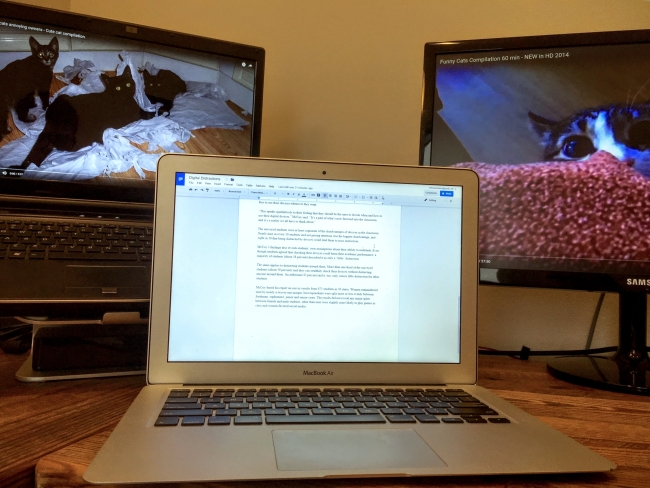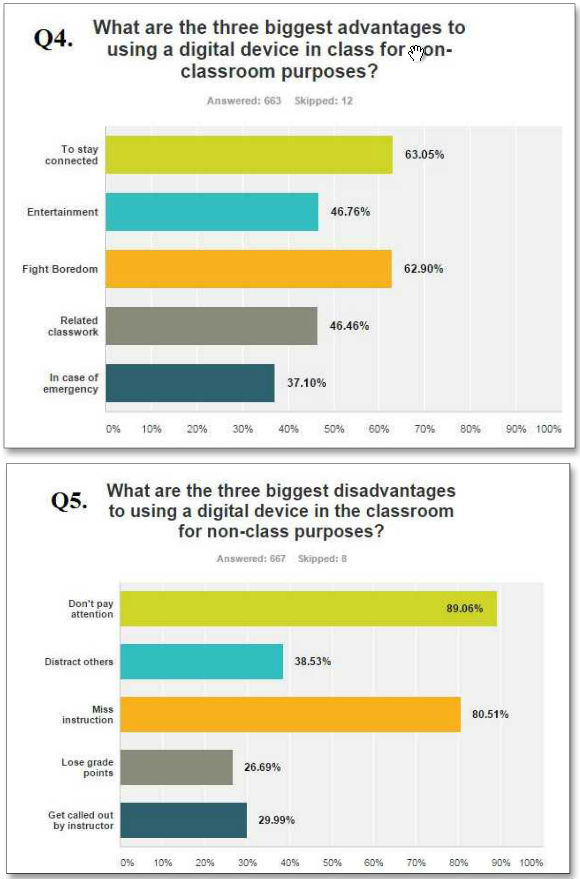You have /5 articles left.
Sign up for a free account or log in.

Illustration Photo
Students waste about one-fifth of class time on laptops, smartphones and tablets, even though they admit such behavior can harm their grades, a new report found.
The average student uses those devices for “nonclass purposes” -- in other words, texting, emailing and using social media -- 11.43 times in class during a typical day. Since the survey was first conducted in 2013, the number of times students check their devices has increased from 10.93, according to the results.
Bernard R. McCoy, the associate professor of journalism at the University of Nebraska at Lincoln who conducted both surveys, said the trend is likely to continue as new devices hit the mainstream.
“To me it’s fascinating, interesting and a little scary all at once,” McCoy said in an interview. “If you take a look at the habits of society in general, technology is more available to us than ever before. … Then you think about millennials. They are the true digital natives. They’ve only known the Internet and the technologies associated with it.”
The report, “Digital Distractions in the Classroom Phase II: Student Classroom Use of Digital Devices for Non-Class Related Purposes,” appears in this month’s edition of the Journal of Media Education, a publication of the Broadcast Education Association.
The results offer a fresh set of data points in the conversation about the role of devices in the classroom. Previous research on the topic paints a nuanced picture. For example, a 2014 study out of Michigan State University found that web surfing in class hurt students' performance regardless of their intellectual ability. Other studies have hinted at some potential benefits, such as an article that appeared in Communication Education last year that suggested texting about a topic taught in class can serve as note taking.
“Students have the opportunity to use this technology to be able to satisfy their own information needs,” said McCoy, who called the increase in device usage a “dual challenge.” Students need to communicate how they would like to see devices used in the classroom, he said, while “colleges and universities have to provide more updated technology and support for instructors so [they] can more effectively use these tools for better student engagement.”
Why do students peek at their devices during class? McCoy’s results suggest two competing reasons. About 63 percent of surveyed students said they do so to stay connected, but an equally large share of students said they are attempting to fight boredom. Other explanations, such as working on related course work or monitoring in case of an emergency, followed with 46.4 percent and 37.1 percent, respectively.
Students also overwhelmingly support using devices in the classroom, with about 90 percent of respondents saying devices should not be banned. The students base their support mainly on two beliefs: that they can use devices without being significantly distracted, and that they should be free to use their devices whenever they want. A smaller number of students said whatever they use the devices for outweighs the distractions it may cause (12.8 percent), or that they simply can't stop themselves from looking (11.5 percent).
“This speaks qualitatively to their feeling that they should be the ones to decide when and how to use their digital devices,” said McCoy, adding that students' opinions can't solely be attributed to a sense of entitlement. “It’s a part of what’s now factored into the classroom, and it’s a reality we all have to think about.”
The findings clash with results of a survey conducted by learning management system provider Instructure, also released today. That survey, which asked faculty members and K-12 teachers around the world about their feelings on technology in the classroom, found that respondents were most concerned about the devices' ability to distract.
The students in McCoy's survey were at least cognizant of the disadvantages of devices in the classroom. Nearly nine in every 10 students said not paying attention was the biggest disadvantage, and eight in 10 said being distracted by devices could lead them to miss instruction.
McCoy’s findings also reveals students’ own assumptions about their ability to multitask. Even though students agreed that checking their devices could harm their academic performance, a majority of students (about 58 percent) described it as only a “little” distraction.
The same applies to distracting students around them. More than one-third of the surveyed students (about 39 percent) said they can stealthily check their devices without distracting anyone around them. An additional 42 percent said it, too, only causes little distraction for other students.
McCoy based his report on survey results from 675 students at four-year institutions in 26 states. Women outnumbered men by nearly a two-to-one margin, but respondents were split more or less evenly between freshmen, sophomores, juniors and seniors. The results did not reveal any major splits between female and male students, other than finding men were slightly more likely to play games in class and women favored social media.









